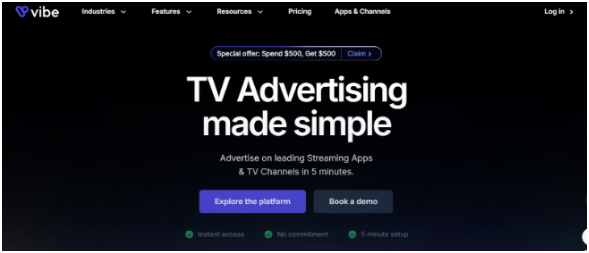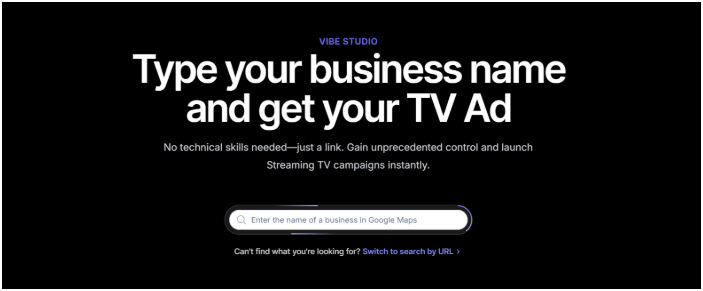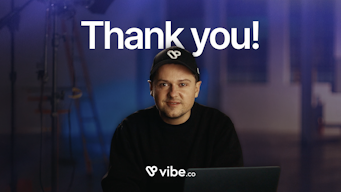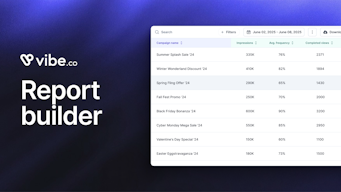AVOD vs SVOD vs TVOD: What Are the Differences and Which Model Works Best?
If you’re exploring video-on-demand (VOD), you’ve likely come across terms like AVOD, SVOD, and TVOD. These models power platforms like YouTube, Netflix, and iTunes, but choosing the right one can be confusing.
Which model reaches the biggest audience? Which generates the most revenue? And why is AVOD gaining so much attention?
In this blog, you’ll learn:
- The basics of AVOD, SVOD, and TVOD with real-life examples.
- A comparison of their costs, scalability, and audience reach.
- Why AVOD is trending and how platforms like Vibe.co maximize its potential.
Whether you’re a content creator or a business owner, this guide will help you understand and choose the best VOD model for your goals.
Before we get into the details, let’s take a quick look at the main differences between AVOD, SVOD, and TVOD.
AVOD vs SVOD vs TVOD: Quick Comparison Table
| Feature | AVOD (Advertising-based Video on Demand) | SVOD (Subscription Video on Demand) | TVOD (Transactional Video on Demand) |
|---|---|---|---|
| Cost for Viewers | Free with ads | Paid subscription | Pay-per-view or one-time purchase |
| Revenue Model | Advertiser-funded | Subscription-based | Transaction-based |
| Audience Reach | Broad and inclusive | Limited to subscribers | Niche or one-time users |
| Content Availability | Large library, ad-supported | Exclusive, premium content | Niche or event-based content |
| Scalability | High; mass-market appeal | Moderate; reliant on subscriber growth | Limited; depends on one-off transactions |
| Examples | YouTube, Vibe.co, Peacock | Netflix, Disney+, Amazon Prime Video | iTunes, Google Play Movies, Vimeo On Demand |
| Best For | Broad audience and ad-supported content | Loyal, engaged subscribers with premium needs | Niche audiences or event-specific content |
What Is AVOD?
Advertising-based Video on Demand (AVOD) is a model where viewers can watch content for free.
Instead of charging viewers a subscription fee, platforms generate revenue by showing advertisements.
This setup allows users to access content at no cost while enabling platforms to sustain their operations through ad revenue.
To understand AVOD better, let’s look at its main features:
- Free Access for Viewers: Viewers do not need to pay to watch content. Instead, they see ads during or between videos.
- Ad-Supported Revenue: Platforms earn money from advertisers who pay to show ads to the audience.
- Broad Audience Appeal: Because it is free, AVOD attracts a wide and diverse audience, including those who may not afford subscriptions.
These features make AVOD an attractive model for platforms aiming to maximize reach and provide accessible content.
Examples of AVOD Models:
Popular platforms successfully using the AVOD model include:
- YouTube: It offers millions of videos for free, earning revenue through ads that play before or during the videos.
- Peacock: The platform provides a free tier that is entirely funded by advertisements, offering viewers access to a wide variety of shows and movies.
Pros for Businesses Using AVOD Models:
AVOD provides several advantages for businesses looking to monetize content:
- Wide Audience Reach: Free content appeals to a larger audience, helping businesses attract more viewers.
- Steady Revenue Stream: Platforms generate consistent income by selling ad space to advertisers.
- Targeted Advertising: By leveraging viewer data, businesses can ensure ads are more relevant, increasing their effectiveness.
Cons for Businesses Using AVOD Models:
Despite its benefits, AVOD also has some drawbacks:
- Viewer Ad Fatigue: If too many ads are shown, viewers might get frustrated and stop engaging with the content.
- Reliance on High Viewership: Revenue depends on maintaining a steady and large number of viewers, which can be challenging.
AVOD is an effective model for reaching large audiences who prefer free content.
However, its success relies on maintaining a careful balance between ad frequency and viewer satisfaction.
Platforms that manage this balance well can build a loyal audience while generating substantial revenue through ads.
What Is SVOD?
Subscription Video on Demand (SVOD) is a model where viewers pay a recurring fee to watch content.
Unlike ad-supported platforms, SVOD provides an ad-free experience, focusing on premium content.
Users pay monthly or yearly, gaining access to exclusive shows, movies, and series.
Here’s what makes SVOD stand out:
- Premium, Exclusive Content: Subscribers get access to unique shows and movies that aren’t available for free elsewhere.
- Predictable Revenue Model: Platforms generate consistent income through recurring subscription payments.
- Ad-Free Viewing: Users enjoy uninterrupted content, making the experience smooth and engaging.
These features make SVOD platforms attractive to users who value high-quality content and ad-free experiences.
Examples Of SVOD Models:
Let’s look at some platforms that excel with this model:
- Netflix: Offers original series, movies, and licensed content to its global subscriber base.
- Disney+: Provides family-friendly movies, Marvel, Star Wars, and exclusive Disney originals.
- Amazon Prime Video: Combines original productions with a vast library included in the Amazon Prime membership.
Each of these platforms demonstrates how SVOD can successfully cater to a diverse audience with exclusive content.
Pros for Businesses Using SVOD Models:
SVOD brings several advantages for companies adopting this model:
- Reliable Revenue Streams: Monthly or annual payments ensure consistent income for the platform.
- Loyal Subscriber Base: Users who value ad-free content are likely to stay longer.
- Higher Value Per User: Revenue per subscriber is higher compared to ad-supported models.
These benefits make SVOD a stable and profitable choice for businesses focused on premium offerings.
Cons for Businesses Using SVOD Models:
However, this model also comes with challenges:
- High Content Costs: Creating or acquiring exclusive shows and movies can be expensive.
- Limited Reach: Platforms may struggle to attract audiences unwilling or unable to pay for subscriptions.
- Subscriber Retention Pressure: Platforms must continuously deliver fresh content to keep users engaged.
These challenges require careful planning and constant innovation to ensure long-term success.
SVOD works best for platforms that prioritize consistent revenue and exclusive content. It appeals to users who are willing to pay for high-quality, uninterrupted entertainment.
Platforms like Netflix and Disney+ show how businesses can thrive with SVOD by investing in engaging, unique content while maintaining a seamless user experience.
What Is TVOD?
Transactional Video on Demand (TVOD) is a model where viewers pay for each piece of content they want to watch.
Unlike subscription models, TVOD charges users a one-time fee, either to rent or buy specific content. This approach is ideal for platforms offering exclusive or event-driven material.
Let’s break down the key aspects of TVOD:
- One-Time Payment: Users only pay when they want to access content, such as a movie or a special event.
- Exclusive Content Focus: Platforms often use TVOD for newly released movies, live events, or niche productions.
- No Subscription Needed: Viewers don’t have to commit to ongoing payments, making it a flexible option for occasional use.
These features make TVOD particularly suitable for content that holds unique value or limited-time appeal.
Examples of TVOD Models:
Several platforms have built their success around the TVOD model:
- iTunes: It allows users to rent or buy movies and TV shows, offering flexibility for one-time use or ownership.
- Google Play Movies: It provides an extensive catalog of content available for individual purchase or rental.
- Vimeo On Demand: It focuses on independent films and niche productions, catering to a more specific audience.
Pros for Businesses Using TVOD Models:
TVOD comes with distinct advantages for businesses:
- Immediate Revenue: Every rental or purchase generates instant income, creating a clear return per transaction.
- Perfect for Exclusive Releases: It works well for premium content like blockbuster movies, concerts, or limited-time events.
- Flexibility in Offerings: Businesses can cater to occasional viewers without requiring long-term subscriptions.
These factors make TVOD an effective choice for platforms with unique or highly demanded content.
Cons for Businesses Using TVOD Models:
Despite its advantages, TVOD has some challenges:
- Smaller Audience: Only viewers willing to pay per title will engage, limiting overall reach compared to free or subscription models.
- Uncertain Revenue: Income depends on the popularity of individual titles, which can vary significantly.
- High Marketing Costs: Each piece of content requires dedicated promotion to attract enough viewers.
These drawbacks highlight the importance of strong marketing and high-value content in making TVOD successful.
TVOD is a practical choice for platforms offering high-demand, premium content that viewers are willing to pay for. However, its success relies heavily on creating and marketing valuable content.
Platforms like iTunes and Google Play Movies show that when paired with exclusive releases, TVOD can generate significant revenue and cater to specific audience needs.
AVOD vs SVOD vs TVOD: What’s the Difference?
Choosing between AVOD, SVOD, and TVOD can feel challenging, especially when each model has unique benefits.
To help you decide, here’s a comparison that highlights the differences in cost, revenue, content, audience engagement, and scalability.
This breakdown will help you understand how AVOD vs SVOD vs TVOD stack up and which one might work best for your goals.
| Aspect | AVOD | SVOD | TVOD |
|---|---|---|---|
| Cost for Viewers | Free to watch but includes ads. | Paid subscription with recurring fees. | Pay-per-view or one-time purchase. |
| Revenue Model | Funded by advertisements from businesses. | Generates income through subscription payments. | Earns revenue from individual rentals or purchases. |
| Content Availability | Broad, ad-supported library for general audiences. | Exclusive, premium content with no ads. | Specific, high-value, or event-driven content. |
| Audience Engagement | High reach but interrupted by ads. | Loyal audience due to ad-free experience. | Focused engagement tied to specific content. |
| Scalability | Highly scalable; free model attracts mass audiences. | Growth depends on acquiring and retaining subscribers. | Limited scalability due to one-time transactions. |
Each model serves different purposes. If you’re looking to maximize reach with a free offering, AVOD is the way to go. For consistent revenue through a loyal audience, SVOD is ideal. And if you’re targeting occasional viewers for specific content, TVOD fits the bill.
Understanding AVOD vs SVOD vs TVOD is essential for selecting the right model for your platform or content strategy.
Why AVOD Is the Best Model
AVOD, or Advertising-based Video on Demand, outshines other models like SVOD and TVOD due to its ability to balance accessibility, profitability, and scalability.
Here’s why AVOD has the upper hand:
| Key Advantage | AVOD | Comparison with SVOD and TVOD |
|---|---|---|
| Reaches the Largest Audience | Attracts a broad audience with free content, removing financial barriers. | SVOD requires subscriptions; TVOD charges per title, limiting reach. |
| Cost-Effective for Businesses | Lower ad costs make it accessible for small businesses. | SVOD and TVOD depend on direct viewer payments, limiting advertiser opportunities. |
| Delivers Targeted Ads | Uses data for personalized ads, boosting engagement and ROI. | SVOD does not use ads; TVOD lacks scale for targeted advertising. |
| Flexibility and Scalability | Combines free and paid tiers, enabling diversified revenue streams. | SVOD and TVOD lack the scalability of hybrid models. |
| Strikes a Balance | Balances accessibility and profitability with ad-supported free content. | SVOD and TVOD are less inclusive and scalable. |
If you aim to grow your audience, maximize engagement, and maintain cost-effectiveness, AVOD is the superior choice.
As AVOD continues to grow as a preferred model for reaching diverse audiences, advertisers need effective tools to make the most of this opportunity. This is where Vibe.co comes in.
How Vibe.co Helps Businesses Succeed with AVOD

Vibe.co simplifies advertising on AVOD platforms by offering tools for easy ad creation, precise targeting, and effective campaign management.
Here’s how it supports businesses in making the most of AVOD:
- Streamlines Ad Creation with Vibe Studio: Vibe Studio, a feature of Vibe.co, allows businesses to create ads quickly, even without prior experience.

It pulls information like business names, images, and descriptions from sources such as Google My Business to generate professional ads.
These ads can be tailored to AVOD platforms, ensuring they are ready for wide distribution.
- Delivers Targeted Advertising: Vibe.co enhances AVOD’s strength by enabling precise audience targeting.
Businesses can use its tools to focus ads based on viewer demographics, location, or interests. This ensures ads are relevant, increasing engagement and maximizing ROI.
- Provides Real-Time Analytics: With Vibe.co, businesses can monitor the performance of their ads on AVOD platforms in real time.
Metrics like impressions, viewer engagement, and conversions help advertisers optimize campaigns quickly, ensuring better results.
- Reaches Multiple AVOD Platforms: Vibe.co connects businesses to over 500 streaming channels, expanding their reach across various AVOD platforms.
This multi-platform access makes it easier to scale campaigns and reach a larger audience.
Vibe.co bridges the gap for businesses wanting to advertise on AVOD platforms like Hulu or YouTube.
It simplifies ad creation with Vibe Studio, offers data-driven targeting, and ensures campaigns perform effectively.
For any business looking to leverage AVOD, Vibe.co provides the tools and support needed for success.
By using Vibe.co, businesses can fully utilize the potential of AVOD, ensuring wider audience reach and better campaign performance.
Also Read: FAST vs AVOD: 5 Differences You Need to Know
Conclusion: Choosing the Right VOD Model
Choosing between AVOD, SVOD, and TVOD depends on your goals and audience needs. Here’s a quick summary:
- AVOD: Best for reaching large audiences with free, ad-supported content, and ideal for emerging markets and cost-conscious viewers. It’s scalable and works well in emerging markets.
- SVOD: Perfect for loyal subscribers seeking premium, ad-free experiences with exclusive content.
- TVOD: Great for niche, high-demand content where users pay per view or purchase.
If scalability and accessibility are your priorities, AVOD stands out. Its ability to attract large audiences and generate revenue through targeted ads makes it a game-changer, especially for businesses aiming to grow their reach.
Why AVOD Matters Now
With tools like Vibe.co, businesses can easily tap into AVOD’s potential. From creating ads to precise targeting and real-time analytics, Vibe.co simplifies the process, ensuring maximum ROI.
Are you ready to unlock AVOD’s potential? Start leveraging Vibe.co to deliver impactful, data-driven campaigns and take your business to the next level.



